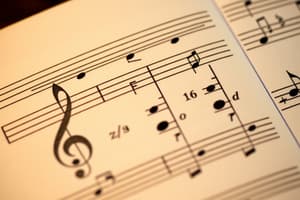Podcast
Questions and Answers
In musical notation, what does a dot placed after a note (e.g., a dotted quarter note) primarily indicate?
In musical notation, what does a dot placed after a note (e.g., a dotted quarter note) primarily indicate?
- Increases the duration of the note by half of its original value. (correct)
- Doubles the duration of the note.
- Indicates the note should be played staccato.
- Halves the duration of the note.
If a piece of music is described as being in a 'Moll' tonart, what is the most likely emotional quality or atmosphere it conveys?
If a piece of music is described as being in a 'Moll' tonart, what is the most likely emotional quality or atmosphere it conveys?
- Melancholy (correct)
- Joyful
- Frantic
- Triumphant
In the context of music, what is a 'Ritornell'?
In the context of music, what is a 'Ritornell'?
- A complex chord progression indicating a key change.
- A free-form improvisational section in a concerto.
- A recurring instrumental passage or refrain that returns throughout a musical piece. (correct)
- A type of percussion instrument commonly used in folk music.
Which of the following is the most accurate description of 'Stabspiele' instruments?
Which of the following is the most accurate description of 'Stabspiele' instruments?
What is the primary playing technique for woodwind instruments?
What is the primary playing technique for woodwind instruments?
What is the role of 'Lippenanspannung' in playing a brass instrument?
What is the role of 'Lippenanspannung' in playing a brass instrument?
In music education, what does 'Werkhören' generally involve?
In music education, what does 'Werkhören' generally involve?
What is the significance of the 'Zwerchfell' in the context of singing and playing wind instruments?
What is the significance of the 'Zwerchfell' in the context of singing and playing wind instruments?
Which term describes the setting of the vocal cords and lips during speech or singing?
Which term describes the setting of the vocal cords and lips during speech or singing?
In the context of analyzing music for educational purposes, what does a 'thematische Ausrichtung' primarily refer to?
In the context of analyzing music for educational purposes, what does a 'thematische Ausrichtung' primarily refer to?
How does 'Volltakt' relate to the understanding of musical rhythm?
How does 'Volltakt' relate to the understanding of musical rhythm?
What is the most common material used in the construction of string instruments?
What is the most common material used in the construction of string instruments?
Which category of musical instruments includes the conga, djembe, and bongos?
Which category of musical instruments includes the conga, djembe, and bongos?
Which of the following are considered instruments in the 'Kleines Schlagwerk' category?
Which of the following are considered instruments in the 'Kleines Schlagwerk' category?
What is one of the primary playing techniques for string instruments?
What is one of the primary playing techniques for string instruments?
Which aspect of Liedeinführung involves connecting specific movements to a song?
Which aspect of Liedeinführung involves connecting specific movements to a song?
What does the Methodenhinführung refer to?
What does the Methodenhinführung refer to?
What does 'Auftakt' refer to in musical terms?
What does 'Auftakt' refer to in musical terms?
Which of the following fall under the UV-Möglichkeiten (allgemein) category?
Which of the following fall under the UV-Möglichkeiten (allgemein) category?
Which technique is employed in playing string instruments?
Which technique is employed in playing string instruments?
Flashcards
Notenwerte (Note Values)
Notenwerte (Note Values)
The duration of a musical note.
Pause (Rest)
Pause (Rest)
A musical symbol indicating silence.
Ganze Note (Whole Note)
Ganze Note (Whole Note)
A whole note lasts for four beats.
Halbe Note (Half Note)
Halbe Note (Half Note)
Signup and view all the flashcards
Viertelnote (Quarter Note)
Viertelnote (Quarter Note)
Signup and view all the flashcards
Achtelnote (Eighth Note)
Achtelnote (Eighth Note)
Signup and view all the flashcards
Rhythmusbausteine (Rhythmic Building Blocks)
Rhythmusbausteine (Rhythmic Building Blocks)
Signup and view all the flashcards
Punktierte Noten (Dotted Notes)
Punktierte Noten (Dotted Notes)
Signup and view all the flashcards
Stammtonleiter (Diatonic Scale)
Stammtonleiter (Diatonic Scale)
Signup and view all the flashcards
Halbtonleiter (Chromatic Scale)
Halbtonleiter (Chromatic Scale)
Signup and view all the flashcards
Takt-Art (Time Signature)
Takt-Art (Time Signature)
Signup and view all the flashcards
Betonung (Emphasis)
Betonung (Emphasis)
Signup and view all the flashcards
Lernbereiche (Learning Areas)
Lernbereiche (Learning Areas)
Signup and view all the flashcards
Intervalle (Intervals)
Intervalle (Intervals)
Signup and view all the flashcards
Rondo
Rondo
Signup and view all the flashcards
Tonart (Key/Mode)
Tonart (Key/Mode)
Signup and view all the flashcards
Spieltechnik (Playing Technique)
Spieltechnik (Playing Technique)
Signup and view all the flashcards
Holzblasinstrumente. (Woodwind instruments)
Holzblasinstrumente. (Woodwind instruments)
Signup and view all the flashcards
Study Notes
Notenwerte
- Ganze Note: 𝅝 (entspricht einem Wert von 1)
- Halbe Note: 𝅗𝅥 (entspricht einem Wert von 1/2)
- Viertelnote: ♩ (entspricht einem Wert von 1/4)
- Achtelnote: 🎵 (entspricht einem Wert von 1/8)
Rhythmusbausteine
- Löwe: ♩ ♩ (ta ta)
- Schildkröte: 🎵🎵♩ (titi ta)
- Papagei: ♩. ♩ (tai ti)
- Klapperschlange: ♩ 🎵🎵🎵 (ta titititi)
- Bär: ♩ (ta)
Note
- Notenkopf: O
- Notenhals: ←
Pausen
- Ganze Pause: ▬
- Halbe Pause: ▭
- Viertelpause: 𝄽
- Achtelpause: ♬
Punktierte Noten
- Ein Punkt hinter einer Note verlängert diese um die Hälfte ihres Wertes.
- d. = d + 🎵 (Punkt hinter Viertelnote = Viertelnote + Achtelnote)
- ♩. = ♩ + 🎵 (tai ti)
- ♩.. = ♩. + 🎵🎵 (tai taja ta)
Stammtonleiter (8)
- c, d, e, f, g, a, h, c'
Takt-Art - Betonung
- 4/4 Takt: Erster Ton betont (>)
- 3/4 Takt: Erster Ton betont (>)
- 4/4 Takt: Erster und dritter Ton betont
#/♭
- #: cis, dis, fis, gis, ais
- ♭: des, es, ges, as, b
- (12 Halbtonleiter)
Lernbereiche LP-PLUS
- Sprechen - Singen - Musizieren
- Musik - Mensch - Zeit
- Bewegung - Tanz - Szene
- Musik und ihre Grundlagen
Intervalle
- Prim
- Sekunde
- Terz
- Quarte
- Quinte
- Sexte
- Septime
- Oktave
Fachbegriffe
- Rondo: Wiederkehrendes Hauptthema
- Intervall: Tonstufen / -sprünge
- Ritornell: Alle spielen einen Rhythmus -> A-A-A
- Couplet: Dazwischen spielen Gruppen ihren Rhythmus -> A-B-C
Tonart
- Dur: Fröhlich (außen)
- Moll: Traurig (innen)
Volltakt/Auftakt
- Volltakt: 4/4
- Auftakt: 1/4, 3/4
Blechblasinstrumente
- Tuba
- Horn
- Trompete
- Posaune
- Material: Hauptsächlich aus Metall mit Trichter/Kesselmundstück
- Spieltechnik: Verändern der Lippenanspannung & Regulieren der Züge/Ventile
Holzblasinstrumente
- Querflöte
- Oboe
- Klarinette
- Saxophon
- Fagott
- Material: Traditionell aus Holz gebaut (zumindest das Mundstück)
- Spieltechnik: Anblasen eines Mundstücks - durch Schwingung eines Rohrblattes.
Streichinstrumente
- Violine/Geige
- Viola/Bratsche
- Violoncello
- Kontrabass
- Material: Aus Holz, meist mit Bogen aus Pferdehaaren
- Spieltechnik: Durch Zupfen oder Streichen, entstehen von Schwingung
Fellinstrumente
- Conga
- Schellentrommel/Tamburin
- Schellenring
- Handtrommel
- Pauke
- Djembe
- Bongos
- "Vom Körper zum Instrument alle Lernen alles"
Kleines Schlagwerk
- Klanghölzer
- Guiro
- Cabasa
- Rasseln
- Becken
- Triangel
- Schellenstab
- (Stiel)Kastagnetten
- Fingerzimbeln
- Glockentanz
- Wooden Agogo
- Röhrentrommel
Stabspiele
- Klangbausteine
- Xylophon
- Glockenspiel
- Metallophon
- → Pentatonik
Effektinstrumente
- Cajon
- Gong
- Agogo
- Kuhglocke
- Kuhglocke
- Rainmaker
- Vibraslap
- Boomwhacker
Zwerchfell bei der Atmung
- Einatmung erfordert das Absinken des Zwerchfells.
- Ausatmung erfordert das Heben des Zwerchfells.
Stimmbänder beim Singen
- Schleimhaut- und Muskelbestandteile der Stimmlippen
- Stimmritze, Luftröhre sichtbar
- Defizite: Unzureichende Tonausschöpfung, ungesunde Stimmlagen, Falsch-, Sprech- & Tiefsänger
- Ursachen: Falsche Übung, falsche Vorbilder, Dauerbeschallung, Fehler in Stimmtechnik
- Stimmbildung: Durch Training, Körper, Atmung, Stimme
- Spielerisch, ganzheitlich, bewegungsorientiert & situativ
- Zungenbrecher, Stimmbilderkartei, Würfelspiel
Liedanalyse
- Thematische Ausrichtung: Inhaltlich- außermusikalisch
- Erfahrung-/Erlebniswelt, Altersgemäßheit, Geschichte, Gefühle, Fächerintegration
- Liedstruktur: Inhaltlich - musikalischer Aspekt
- Aufbau/Liedform (z.B. einteilig/zweiteilig...)
- Taktart (z.B. ¾ Takt/Volltakt/Auftakt/...)
- Rhythmus (z.B. Notenart + Rhythmus bausteine)
- Text (z.B. wo silbe?/Reime/ Worterklärungen)
- Tonart (z.B. G - Dur + Akkord)
- Melodie (z. B. Intervallsprünge/ Wiederholungen/Ambitus d'-a'-"Quinte)
- Harmonik (z.B. Akkordarten)
- Didaktisch-methodische Überlegungen
- Umgangsmöglichkeiten (Refrain/Strophe)
- Klatschen tanzen…
- Bild Verto nung, Liedpuzzle
- Fazit
- Warum ausgewählt. wo wie einsetzbar als was?
Liedeinführung
- Vorsingen & Klatschen
- Pausen füllen mit Bodypercussion
- Gruppenaufteilung
- Bewegung (Choreo)
- Melodie nach & nach ansteuern
Einsatzmöglichkeiten im Unterricht (Liedeinführung)
- Erfinden von rhythmischen Sprech- & Klatschstücken
- Rhythmusbausteine erfinden.
- Horquiz
- Musikalische Begleitung
- Erfinden eigener Rhythmen.
Methodenhinführung
- Methoden: Papageienmethode, Inselmethode, Text & Rhythmus, Melodie & Rhythmus
- Motorisch, visuell, taktil, akustisch, emotional, kognitiv musikalisch.
UV-Möglichkeiten (allgemein)
- Tempo Veränderung
- Wiederholung in Dauerschleife
- Liedergarten
- Glasscheibenspiel
- Dirigentenspiel
- Radiospiel.
Methoden des Werkhörens (H. Lemmermann (1978))
- Auffälligkeitssammlung ohne spez. Hörauftrag
- Zuordnungsverfahren: → welches Bild zur Musik?
- Graphische Notation: → z.B. Blumen als Notenfolge
- Teilrealisation: → Teile von Werken realisieren (z.B. cag fga)
- Transformation/Transposition: → Bila malen + Titel
- Themen-/Liedbrücke: → dt. Nationalhymne zur Europahymne
- Parakomposition: → (Wilder Reiter) eigeninitiativ darstellen
- Werkvergleich: → Karneval der Tiere (welche Instrumente & warum?)
- Tanzformen: - Raumerga - Kreistanz O - Reihentanz - Freier Tanz
- Gestaltung: Szenisch, stilisiert, freier Ausdruck, Solo-Gruppen
Hinweise
- Regelmäßige Übung
- Klassenniveau
- Kleine Bewegungsfolgen
- Verbalisieren & Visualisieren
- Partnertänze
- Zeitlupe
Studying That Suits You
Use AI to generate personalized quizzes and flashcards to suit your learning preferences.




